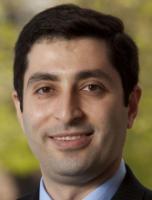
Dr. Ramin Motamed is an Assistant Professor at the University of Nevada, Reno in the Department of Civil & Environmental Engineering where he teaches graduate as well as undergraduate classes including Geotechnical Earthquake Engineering, Advanced Foundation Engineering, Advanced Geotechnical Laboratory and Geotechnical Design of Foundations.
He received his BS and MS degrees from Urmia University and Iran University of Science & Technology in Iran. Dr. Motamed earned his PhD in 2007 from the University of Tokyo where he carried out research on the behavior of pile foundations in laterally spreading ground using E-Defense Shake Table facility and in 2010, he was awarded the prestigious Best Young Researcher Paper Award by the Japanese Geotechnical Society.
From 2009 to 2012, Dr. Motamed, who is a registered engineer in the state of California, was an Engineer & Senior Engineer with Arup in San Francisco. In that capacity, he worked on a variety of high-profile projects in California and Nevada. Some of these projects include the Transbay Transit Center (San Francisco, CA), War Memorial Veterans Building (San Francisco, CA), Apple Campus 2 (Cupertino, CA), Gerald Desmond Bridge (Port of Long Beach, CA), California High-Speed Rail (California) and High Roller Observation Wheel (Las Vegas, NV).
His main areas of research include large-scale shake table testing, pile foundations, liquefaction and lateral spreading, LRFD for deep foundations, and nonlinear site response analysis.
Liquefaction-induced ground failure has accounted for major damage in structures and lifelines for several decades. Well-documented case histories have provided valuable insight into the mechanism of this phenomenon. Recent earthquakes such as the 2010-2011 Canterbury earthquake sequence in New Zealand and the 2011 Great Tohoku earthquake in Japan revealed that the current engineering practice lacks proper consideration of this phenomenon in the design. A large number of low-story structures suffered significant damage resulting from liquefaction-induced settlements in the recent seismic events and reconnaissance of the affected areas has documented extensive damage to buildings with shallow foundations within liquefaction-prone areas.
In this study, an extensive series of 1-g scaled shake table experiments were carried out to reproduce liquefaction-induced building settlements which included comprehensive parametric study to establish the effects of several parameters on free-field and building settlements such as building dimensions, ground motion characteristics, and underlying soil properties.
Results of this experimental study are compared to recent centrifuge tests and field measurements and provide valuable insight into the effects of abovementioned parameters on the liquefaction-induced settlement for both free-field and under building conditions. The scaled model experiments were fully instrumented using accelerometers, LVDTs, and pore water pressure sensors to quantify these effects.
Lindsay Walton
lwalton@ucsd.edu
(858)822-3273
